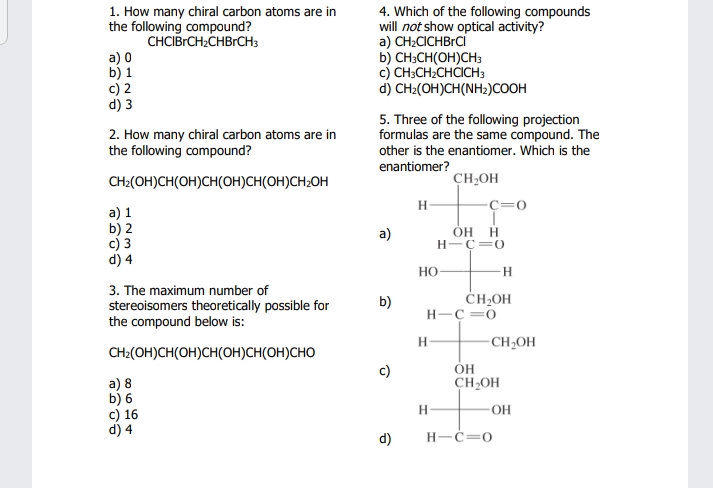the following compound? CHCIBICH:CHBrCH3 a) 0 b) 1 c) 2 d) 3 will not show optical activity? a) CH;CICHBrCi b) CH;CH(OH)CH; c) CH:CH:CHCICH, d) CH2(OH)CH(NH2)COOH 5. Three of the following projection formulas are the same compound. The other is the enantiomer. Which is the enantiomer? 2. How many chiral carbon atoms are in the following compound? CH2(OH)CH(OH)CH(OH)CH(OH)CH;OH CH,OH -ç=0 a) 1 b) 2 c) 3 d) 4 ÓH H H-C=0 a) Но- H 3. The maximum number of stereoisomers theoretically possible for the compound below is: ČHHOH b) H-C =0 -CH;OH CH:(OH)CH(OH)CH(OH)CH(OH)CHO a) 8 b) 6 c) 16 d) 4 CH;OH - OH d) H-C=0
the following compound? CHCIBICH:CHBrCH3 a) 0 b) 1 c) 2 d) 3 will not show optical activity? a) CH;CICHBrCi b) CH;CH(OH)CH; c) CH:CH:CHCICH, d) CH2(OH)CH(NH2)COOH 5. Three of the following projection formulas are the same compound. The other is the enantiomer. Which is the enantiomer? 2. How many chiral carbon atoms are in the following compound? CH2(OH)CH(OH)CH(OH)CH(OH)CH;OH CH,OH -ç=0 a) 1 b) 2 c) 3 d) 4 ÓH H H-C=0 a) Но- H 3. The maximum number of stereoisomers theoretically possible for the compound below is: ČHHOH b) H-C =0 -CH;OH CH:(OH)CH(OH)CH(OH)CH(OH)CHO a) 8 b) 6 c) 16 d) 4 CH;OH - OH d) H-C=0
Organic Chemistry
8th Edition
ISBN:9781305580350
Author:William H. Brown, Brent L. Iverson, Eric Anslyn, Christopher S. Foote
Publisher:William H. Brown, Brent L. Iverson, Eric Anslyn, Christopher S. Foote
Chapter23: Amines
Section: Chapter Questions
Problem 23.22P
Related questions
Question

Transcribed Image Text:1. How many chiral carbon atoms are in
the following compound?
CHCIBRCH2CHBRCH3
a) 0
b) 1
c) 2
d) 3
4. Which of the following compounds
will not show optical activity?
a) CH2CICHBRCI
b) CH;CH(OH)CH3
c) CH;CH2CHĆICH3
d) CH2(OH)CH(NH2)COOH
2. How many chiral carbon atoms are in
the following compound?
5. Three of the following projection
formulas are the same compound. The
other is the enantiomer. Which is the
enantiomer?
CH2(OH)CH(OH)CH(OH)CH(OH)CH2OH
CH,OH
c=0
a) 1
b) 2
c) 3
d) 4
ОН Н
H-C=0
a)
НО
-H
3. The maximum number of
ČHHOH
stereoisomers theoretically possible for
the compound below is:
b)
H-C =0
-CH2OH
CH2(OH)CH(OH)CH(OH)CH(OH)CHO
c)
CH2OH
a) 8
b) 6
c) 16
d) 4
H.
- OH
d)
H-C=0
Expert Solution
This question has been solved!
Explore an expertly crafted, step-by-step solution for a thorough understanding of key concepts.
This is a popular solution!
Trending now
This is a popular solution!
Step by step
Solved in 4 steps with 3 images

Knowledge Booster
Learn more about
Need a deep-dive on the concept behind this application? Look no further. Learn more about this topic, chemistry and related others by exploring similar questions and additional content below.Recommended textbooks for you

Organic Chemistry
Chemistry
ISBN:
9781305580350
Author:
William H. Brown, Brent L. Iverson, Eric Anslyn, Christopher S. Foote
Publisher:
Cengage Learning


Organic Chemistry: A Guided Inquiry
Chemistry
ISBN:
9780618974122
Author:
Andrei Straumanis
Publisher:
Cengage Learning

Organic Chemistry
Chemistry
ISBN:
9781305580350
Author:
William H. Brown, Brent L. Iverson, Eric Anslyn, Christopher S. Foote
Publisher:
Cengage Learning


Organic Chemistry: A Guided Inquiry
Chemistry
ISBN:
9780618974122
Author:
Andrei Straumanis
Publisher:
Cengage Learning